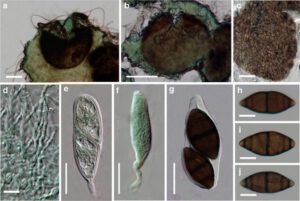Bimuria novae-zelandiae D. Hawksw. et al., N.Z. Jl Bot. 17(3): 268 (1979).
Index Fungorum number: IF 309549; MycoBank number: MB 309549; Facesoffungi number: FoF 00033
Saprobic on terrestrial habitats. Sexual state: Ascomata (185-)200 × 310(-330) μm diam., solitary, scattered, semi-immersed or superficial, globose, hyaline when young, turning dark brown to black when mature, ostiolate, the ostiole more or less sessile or raised into a very short neck. Peridium 5–8 μm diam, comprising 2–3 layers of compressed pseudoparenchymatous cells, the outer layer comprising sub-hyaline at first, but becoming pale brown with age cells of textura angularis, inner wall composed of hyaline radially compressed cells of textura angularis. Hamathecium of dense, 2.5–4 μm broad, septate, cellular pseudoparaphyses, embedded in mucilage, rarely anastomosing and branching. Asci 82–95 × 20–33 μm (x̄ = 75 × 29 μm, n=10), (1-)2(-3)-spored, bitunicate, fissitunicate, broadly clavate, with a short and small knob-like pedicel, ocular chamber best seen in immature asci. Ascospores 55–68 × 25–28 μm (x̄ = 59 × 26 μm, n = 10), accumulating in a subglobose black shiny mass adhering together outside the ostiole, broadly ellipsoid but becoming narrowed towards the poles, muriform with (5-) 7 transverse septa, cells with (0-)l(-2) longitudinal septa in each cell, no constriction at the septa, dark brown, the apical cells paler with no longitudinal septa, verruculose. Asexual state: unknown
Material examined – NEW ZEALAND, North Island, Wairarapa District, Nutty Farm, isolated from soil, 3 Mar. 1978, Chea Chark Yen & J.E. Sheridan (CBS 107.79, isotype)
Notes – Bimuria is a monotypic genus introduced by Hawksworth et al. (1979) and typified by B. novae-zelandiae. Bimuria is characterized by a very thin peridium, mostly 2-spored and fissitunicate asci and muriform, dark brown, verrucose ascospores (Hawksworth et al. 1979). Because of its unique morphological characters, the familial placement of this genus has been debatable, thus initially Hawksworth et al. (1979) placed the genus in Pleosporaceae. Later Barr (1987b) transferred Bimuria to Phaeosphaeriaceae while Lumbsch and Huhndorf (2007) placed it in Melanommataceae. Morphologically, Bimuria is most similar to Montagnula (Hawksworth et al. 1979). However, the thick carbonaceous peridium distinguishes Montagnula from Bimuria (Hawksworth et al. 1979). In addition, the ascospores of Montagnula are discharged forcibly through the ostiole instead of forming a mass outside of the ostiole as in Bimuria (Hawksworth et al. 1979). Ascomauritiana lignicola V.M. Ranghoo & K.D. Hyde has somewhat similar ascospores in 4-spored asci, but this taxon has unitunicate asci (Ranghoo and Hyde 1999). Hawksworth et al. (1979) suggested that the morphological characters of Bimuria, such as ascospore release and large, thick-walled ascospores may be an adaptation to its soil-borne habitat. Combined gene analysis of SSU rDNA, LSU rDNA, RPB2 and TEF1 concluded that the type strain of the Bimuria novae-zelandiae (CBS 107.79) clustered within the family Montagnulaceae (Schoch et al. 2006, 2009). Our phylogenetic study also showed similar results, with Bimuria forming a monophyletic clade sister to Tremateia. Therefore we agree with Barr (2001) and include Bimuria as a well-established genus in Montagnulaceae based on both morphology and phylogeny.

Fig 1. Bimuria novae-zelandiae (isotype). a, b Close up of ascoma. c Hyaline, pseudoparaphyses. d, e, f, g.Two-spored asci with knob-like pedicel. h, i, j Dark -brown, muriform, ascospores. Scale bars: a, b = 100 µm, c= 5 µm,d, e = 10 µm, f, g, h = 30 µm, i, j = 10 µm.
